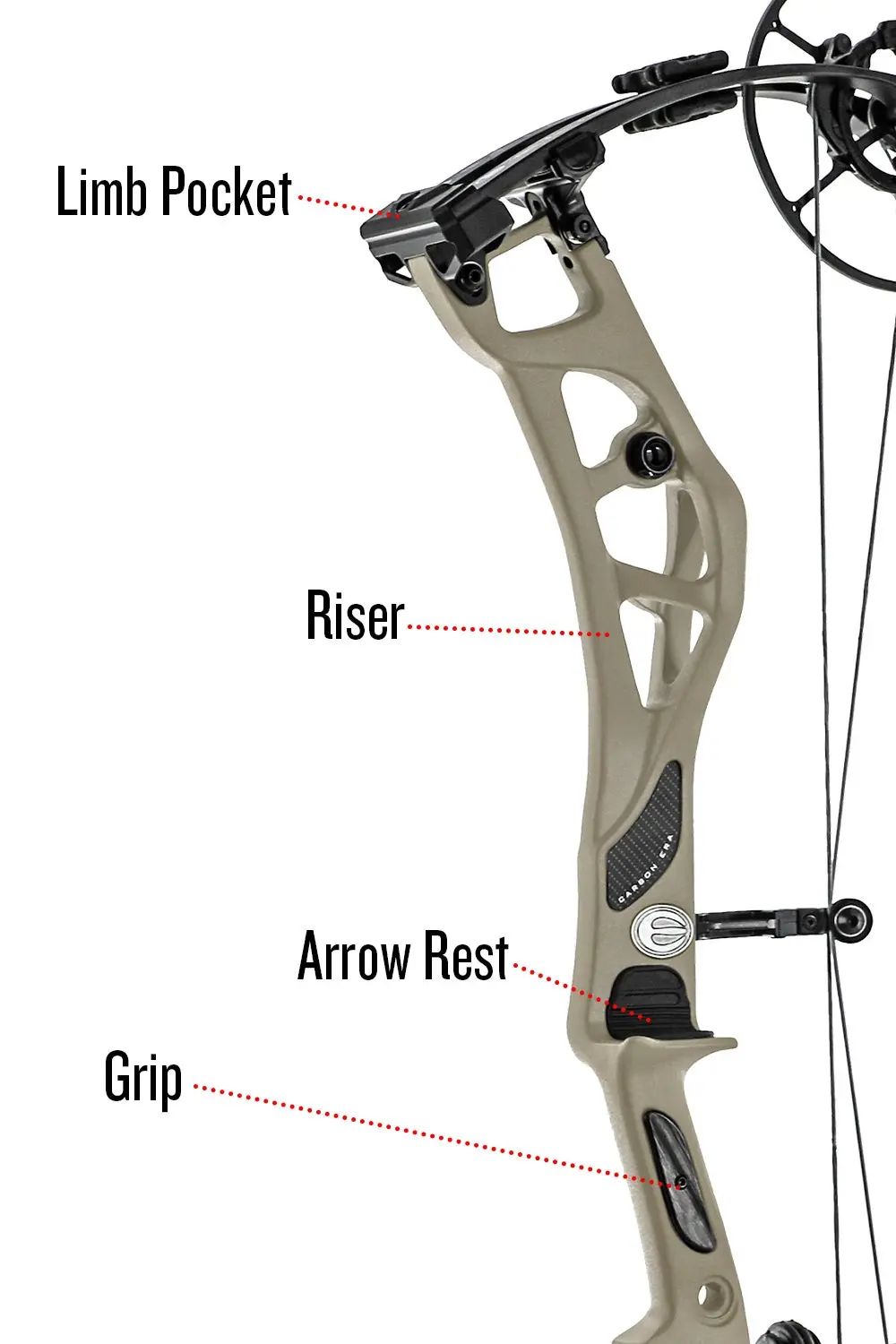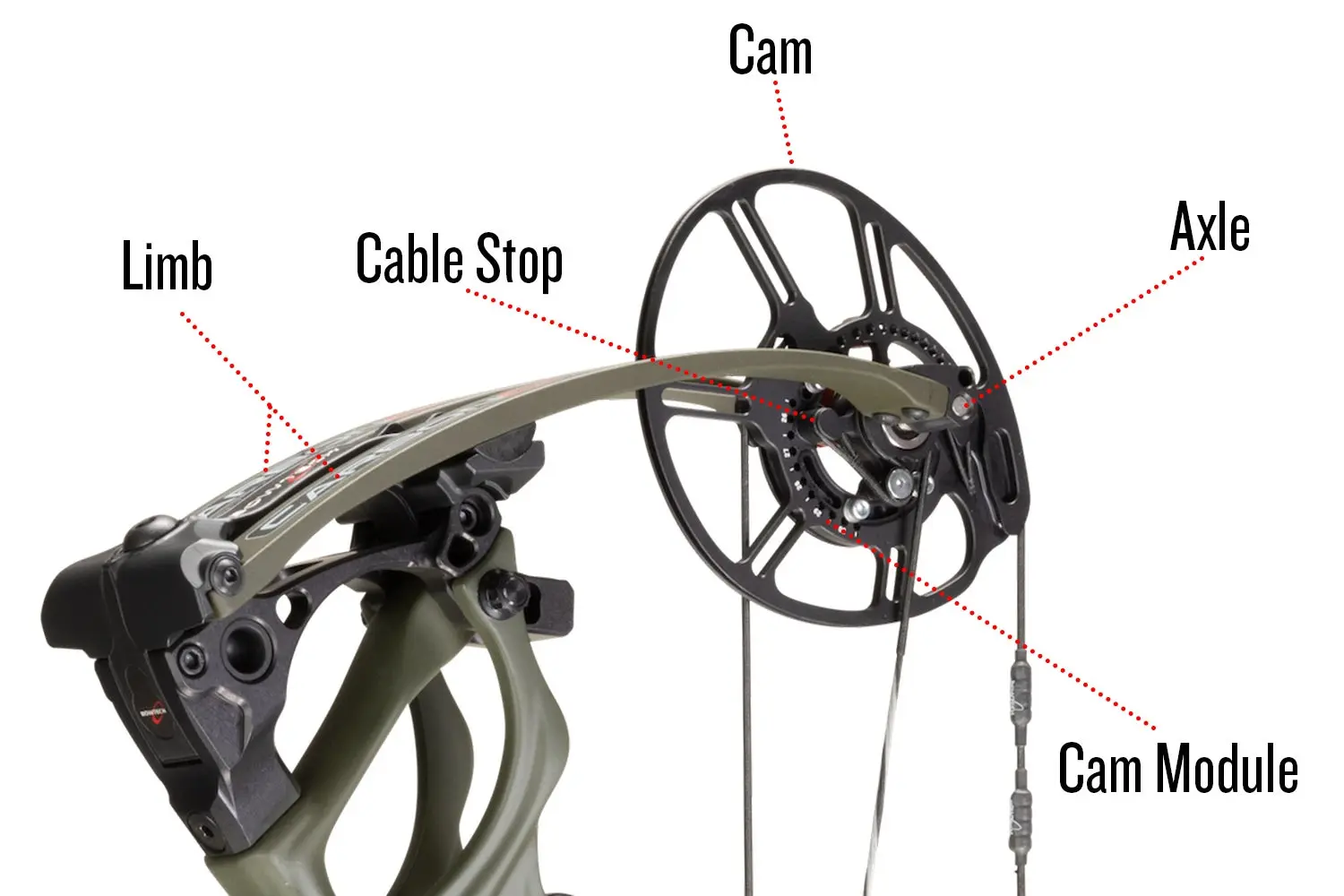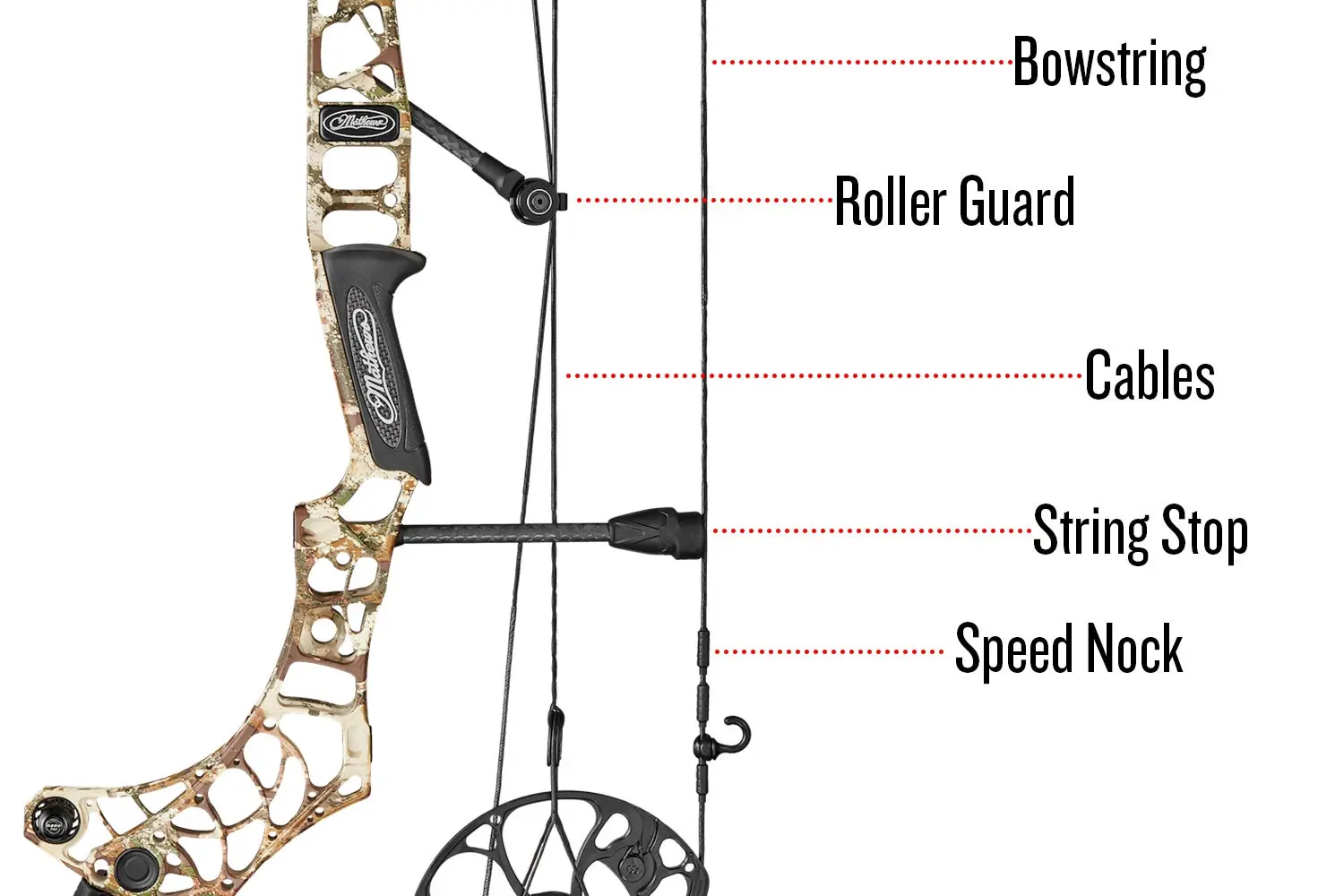_We may earn revenue from the products available on this page and participate in affiliate programs. Learn more ›
_
Every part of a compound bow is a piece of a puzzle, and when all the pieces fit together, you get a tool that produces accuracy, speed, and a balanced feel. Knowing these parts, their location on the bow, and their purpose is helpful for diagnosing issues you might have with your bow, and for evaluating new compound bows
you might want to buy.
The Parts of a Compound Bow
Riser
Arrow Shelf
Grip
Limb Pockets
Limbs
Cam
Axles
Cam Modules
Limb or Cable Stops
Bowstring
D-Loop
Speed Nock
Cables
Cable Slider/Roller Gaurd
String Stop
The Riser

The riser is the centerpiece of a bow. It is part of the compound bow that you hold and where the limbs are attached. There are reflex risers (that curve inward) and deflex risers (that curve outward). Some are made of carbon and some are made from aluminum. Based on the bow’s design risers can be long or short.
Parts of a Compound Bow Riser
Arrow Shelf
The arrow shelf extends out from the main body of the riser, usually around the riser’s midpoint, and it is where the launcher arm of the rest falls. Your arrow will rest on an arrow rest within the arrow shelf.
Grip
This is the part you hold onto. Some grips are “direct-to-riser,” or machined into the riser itself, and others are molded from plastic or carved from wood to fit over the riser.
Limb Pockets
Typically made of aluminum or high-grade plastic, the limb pockets connect the limbs (below) to the riser with a single limb screw. This screw can be turned clockwise and counterclockwise to adjust the bow’s draw weight based on the manufacturer’s settings.
Limbs
As you pull the string back, the limbs flex inward to give the bow power, and at the shot, those limbs return to their stationary position, transferring their energy to the cams, bowstring, and the arrow. Limbs must be durable and are typically made from carbon, fiberglass, and other robust materials. Compound bows are made with single limbs or split limbs. Based on the manufacturer’s configuration, limbs can be set at different angles, such as parallel or beyond parallel.
Cam

The cam is the bow’s engine. Cams sit between the limbs at the top and bottom of the bow. They look like curved wheels. Some can be bigger than others and there are different kinds of cam configurations. (Some bows can have a single cam with an idler wheel, a dual cam, or a hybrid cam, but most hunting bows today have dual cams.)
Their main job is to let pressure off at a certain point during the draw cycle, reducing the amount of force it takes to hold a bow back. With the cams engaged, the archer only has to hold a certain percentage—usually 70, 80, or 85 percent—of the bow’s full draw weight.
Parts of a Compound Bow Cam
Cam Modules
Many compound bows have cam modules allowing the shooter to change the bow’s draw length in 1/2-inch increments without a bow press. There are compound bows (draw-length-specific) that come at a set draw length, and if the archer wants to change that draw length, they’ll need to buy a new cam module.
Limb or Cable Stops
Limbs or cable stops are arms or studded posts on the cams that contact the inner cable or top and bottom limb to stop the string at the correct draw-length setting.
Axles
The axles are what the cams turn on. They are also used as points to measure the bow’s axle-to-axle—or ATA—dimension. The distance between axles on a compound bow typically influences how the bow will feel to the archer. Longer ATA bows tend to have a smoother draw cycle and are a bit slower (in terms of how fast the arrow travels) than shorter ATA bows. Shorter ATA bows tend to be faster
and are more maneuverable in a blind, however, they don’t have as smooth a draw cycle as longer ATA bows.
Bowstring
The bowstring is a string that the archer pulls back to shoot the bow. It makes contact with the arrow at the knock.
Parts of a Compound Bow Bowstring
D-Loop
A cord tied to the bowstring serves as a point to knock an arrow and allows the archer to attach a release aid.
Speed Nock
Small weights, usually covered in a rubberized material, that are attached to the bowstring to reduce residual bowstring oscillation and boost the bow’s performance.
Peep Sight
The peep sight is a small disc with a hole in the middle that gets threaded to the bow string. An archer will align the peep sight to the bow sight to aim the bow.

Cables
Sometimes confused with the bowstring, cables run from cam to cam, through the bow’s cable slide or roller guard, and never touch the arrow.
Cable Slide/Roller Guard
Cable slides and roller guards direct cables and keep them from coming contact with each other as the bow is drawn. Most compound bow designers today use roller guards instead of cable slides. Roller Guards create less friction and boost the longevity of the cables.
String Stop
The string stop is a rubberized pad usually attached to an aluminum, carbon, or high-grade plastic rod that runs out from the back of the riser toward the string. The rubber pad stops the speeding bowstring.
**Read Next: Recurve vs Compound Bow: How to Choose the Best Type of Bow for You
**
Parts of a Compound Bow: Accessories
Sight
Rest
Stabilizer
Quiver
Sight
The sight is used in conjunction with the rear peep-sight to aim an arrow. Sights
are typically made from a circular or oval-shaped housing that contains pins in various configurations. Some sights are adjustable for different ranges while others use multiple fixed pins. All bow sights attach to a bar that attaches to the riser.
Rests
There are drop-away rests and whisker biscuits. A drop-away rest holds the arrow during the draw cycle, and then drops out of the way as the arrow flies out of the bow. There are cable-driven and limb-driven drop-away rests available—each using a different part of a compound bow to function. Whisker biscuits don’t have any moving parts. instead, they use bristles facing inward to hold the shaft of an arrow in place. Both drop-away rests and whisker biscuits mount to the riser.
Stabilizer
The stabilizer helps balance the bow and dampens noise and vibration during a shot. Stabilizers screw into the riser in a threaded hole that is typically set in line with the string stop.
Quiver
A bow-mounted quiver holds extra arrows safely and securely. They are mounted to the riser.
![Field & Stream [dev]](https://images.ctfassets.net/fbkgl98xrr9f/1GnddAVcyeew2hQvUmrFpw/e4ca91baa53a1ecd66f76b1ef472932b/mob-logo.svg)

